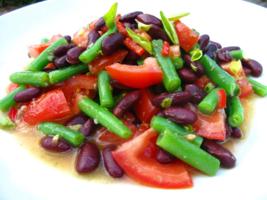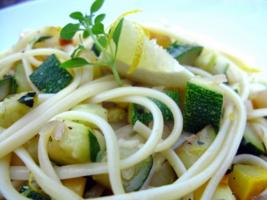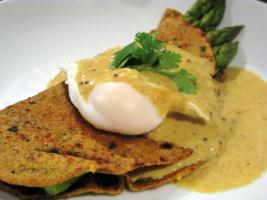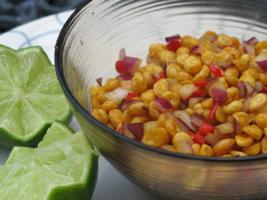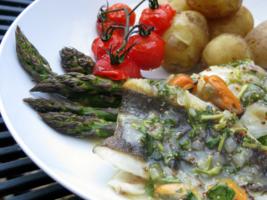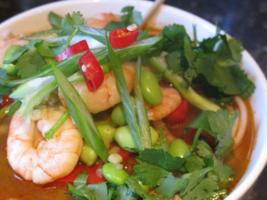So on my first proper cooking day of my Store Cupboard Challenge (I didn't think that Kraft mac n' cheese last night counted ;) I decided it was time to use up the block of white stilton that I had picked up at the weekend. I had never cooked with it before - but as it was only 30p from the deli counter, so figured I would work out a use for it!
I was going to make cheesecake with it, but my biscuits for the base had gone stale. So I set my mind to a savoury plan... What I really fancied was gnocchi, but I didn't have any potatoes. Eventually I hit on ravioli - but other than white Stilton, I couldn't think what to put in it! I wanted to keep it quite soft and rich - most of my available ingredients were too demanding for this!
The combination of porcini, spinach and walnut wasn't one I'd tried before - but the flavours worked well together. Though I think it was a little rich for a main - I think in future I would serve two or three as an appetiser.
Also, I had never made stuffed pasta before - but I'm happy to report it was fairly event-free!
On a completely separate aside, I went to bed fairly soon after eating this, and it did cross my mind to be concerned about cheese-induced nightmares... But that was not to be - I had very bizarre dreams, which were exceptionally vivid - but not bad at all! Today I found this article comparing the effects of eating British cheese on dreams - and according to the study 85% of females who eat Stilton before bed have very vivid and crazy dreams... So go on gals - knock yourselves out!
Ravioli with Walnut, Spinach and Porcini


I'm sending this over to Ruth at
Once Upon A Feast for
Presto Pasta Night - though I think she has put me to shame with
her proper ravioli making equipment!
- 250g white stilton
- 50g dried porcini
- 2 egg yolks
- 1 large bunch spinach
- 2 cloves garlic
- 1 banana shallot
- 1 small handful shelled walnuts, roughly chopped
- 1 handful shelled walnuts, blitzed to crumbs!
- 1 tsp corn flour, dissolved in a couple of tbsps water
- 200g tipo 00 flour
- 2 eggs
- semolina flour for dusting
Pour a cup of boiling water over the porcini and leave to soak for 30 minutes, or until rehydrated. Strain, reserving soaking liquor.
Making the pasta!In a blender, blitz half of the mushrooms to a puree. Heat some olive oil and fry the puree for a couple of minutes.
In the blender, mix the flour, mushroom puree and 2 eggs to make a dough - adding a little of the mushroom liquor if required. Remove from the blender, knead for 2/3 minutes until elastic, wrap in film and refridgerate for at least 30 minutes.
Take a look at my post on
roasted garlic pasta for more details on making and rolling pasta - I won't write out the details again here!
The filling!While the pasta is resting, use your blender (yes again! I can't imagine life without my kenwood! ;) to mix 200g of the white stilton and two egg yolks until fluffy.
Chop the shallot, crush one of the garlic cloves and finely chop the remaining porcini. Over a medium heat, fry these for a few minutes until soft. Add to the stilton mix.
Wilt the spinach for a couple of minutes until soft. Strain and squeeze to remove excess water. Add 3/4 of the spinach to the stilton mix reserving the other quarter for the sauce.
Blitz the mix a few times to combine the ingredients, then add the handful of roughly chopped walnuts.
Season well with salt and black pepper!
Make the Ravioli!Roll out the pasta to the 3rd thinnest setting (
See how to roll here!). Cut sheets into manageable sizes! Lay one sheet of pasta out, and place teaspoons of mixture onto it, leaving enough space round the edges to seal it.

Brush the edges with water, and lay another sheet of pasta on top. Starting from one end of the sheet, use a cupped hand to seal the stuffing inside the pasta - making sure there is no air pockets. Cut the raviolis out, trimming the edges as required.
The Sauce!Dead easy - do this just before serving! Heat a glug of olive oil, crush the remaining garlic clove and fry gently for a minute. Add the remaining spinach, the strained mushroom soaking liquor and the cornflour mix. Stir in the rest of the walnuts, and bring to the boil, then crumble in the remaining stilton. Remove from the heat and stir to melt the cheese into the sauce.
Finishing the Dish!
Cook the ravioli in plenty of boiling salted water for about 3 minutes. Place into a warm dish and drizzle with some olive oil and some of the walnut sauce. Note that the walnut sauce is pretty rich - you don't need much!

